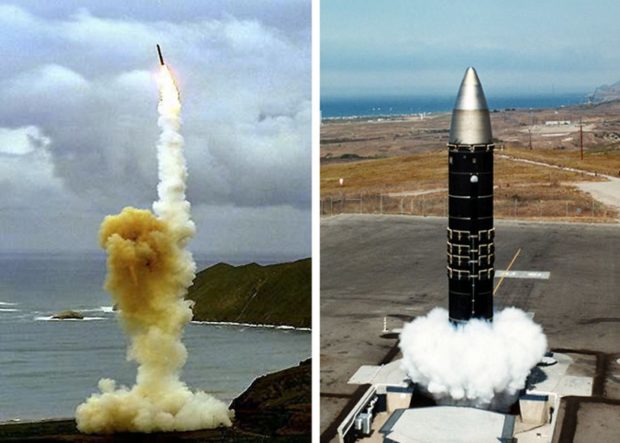
This 28 March, 2004 composite image shows the LGM-30G Minuteman intercontinental ballistic missile (ICBM) (left) and the LG-118A Peacekeeper missile (right). The US military announced that it would upgrade its Minuteman III intercontinental ballistic missiles while retiring its Peacekeeper missile force. The larger, multinuclear-warhead-carrying Peacekeeper ICBMs are being decommissioned as part of the Moscow Treaty brokered between the United States and Russia in May 2002. AFP
WASHINGTON, United States — Hidden underground in steel-and-concrete silos across rural America, more than 400 intercontinental ballistic missiles point to the skies, poised for launch — and ready to obliterate cities across the world.
First designed in the 1960s at the height of the Cold War, the Minuteman nuclear weapons are starting to show their age, and replacement parts are difficult to find for the weapons designed in an analog age.
Also aging are their silos, many built in the 1950s and now rusting as water seeps through the decaying concrete.
Over the next 20 years, the US Air Force will switch out the entirety of its Minuteman III fleet with an as-yet-unnamed new missile known only as the Ground Based Strategic Deterrent (GBSD).
The Air Force estimates the cost of the GBSD, to be introduced late in the 2020s and phased in over the following decade, will be around $86 billion over the missiles’ life cycle of about 50 years.
Critics point to the Defense Department’s long history of projects going way over budget and say the cost of replacing the nukes and maintaining their launch facilities is not warranted, given the tactical threats the United States currently faces.
The Air Force “doesn’t know how we are going to afford this,” said Laicie Heeley, a nuclear expert at the Stimson Center, a nonpartisan anti-nuclear proliferation think tank in Washington.
“Nuclear is crowding out more conventional systems that are (better suited to) the threats of today.”
America’s nuclear triad
The Air Force issued requests for proposals in July for vendors to replace the Minuteman, named after colonial militiamen who eventually fought against the British in America’s Revolutionary War.
The prize will likely go to one of the three US defense giants: Lockheed Martin, Northrop Grumman and Boeing, and the new missile will be equipped with state-of-the-art electronics while being protected from any cyber threats.
America’s intercontinental ballistic missiles (ICBMs) are just one leg of its “triad” — a three-pronged nuclear attack force also comprising submarines and bombers.
The Pentagon wants to replace or modernize all three legs of the triad, at a cost experts estimate will hit $1 trillion over the next 30 years.
“We flat can’t afford it. And from a priorities standpoint, it’s the wrong priority in the world that we face,” Democratic Congressman Adam Smith told a Washington forum last week, noting that the ICBM force is the part of the triad best suited for reduction.
The lawmaker said countries like China are able to boast a “spectacular deterrent” with far fewer nuclear weapons.
“What they have is enough to say ‘Don’t screw with us, or we will obliterate you,'” he said, adding that even if the United States were to enter a major nuclear fight, “we’re pretty much all toast anyways.”
The Pentagon insists it is imperative to push ahead with a complete overhaul of America’s nuclear force.
While the United States and Russia signed a treaty in 2010 to reduce the numbers of nuclear launchers, Moscow is modernizing its own triad.
“The Russians, the Chinese, the North Koreans are upgrading all of their systems,” an Air Force official told AFP, speaking on condition of anonymity to discuss the nuclear program.
“They are upgrading all of their legs of the triad — in that environment, I am not sure it makes sense” to do nothing.
Another Air Force official said many of the vendors who first built or equipped the missile silos have long gone out of business, making it an arduous task to find replacement parts.
He said he’d heard anecdotes of colleagues scouring Ebay or other sites looking for antique components.
The Minuteman fleet is currently dotted across locations in North Dakota, Wyoming and Montana.
Defense Secretary Ashton Carter will on Monday visit Minot Air Force Base in North Dakota, where control centers for that state’s nukes are located.
The Air Force has in recent years battled flagging morale among its “missileers” — airmen in charge of the land-based missile force.
A series of embarrassing revelations in 2014 described the state of the nuclear force, with dozens of airmen disciplined cheating on a test. Other investigations have probed drug use.
The trouble began after the demise of the Soviet Union, as the mission gradually received a lower priority and offered a less-promising career path. CBB